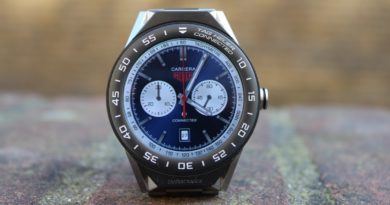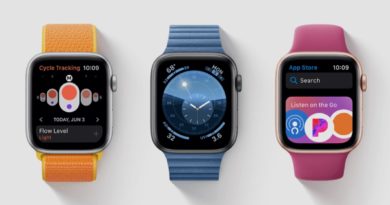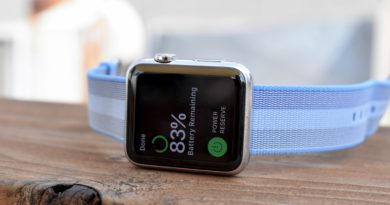How Apple could beat Fitbit to the ultimate sleep tracking wearable
“If you zoom out into the future and you look back and you ask the question ‘What was Apple’s greatest contribution to mankind?’ It will be about health,” said Apple CEO Tim Cook during an interview with CNBC earlier this year.Cook’s prediction may be bold, but it isn’t surprising. The iPhone has had built-in health and fitness tracking features for years and the Apple Watch is one of the best smartwatches and fitness trackers around. Now with potentially lifesaving tech built-in, it’s becoming much more than a lifestyle device.Essential reading: Best Apple Watch sleep tracker appsBut with such a big commitment to health, why is the Apple Watch still missing one key feature: native sleep tracking?According to a Bloomberg report from February 2019, Apple is allegedly working on a sleep monitor that’ll be added to a future version of the Apple Watch. The report states that the company has been trialling the sleep-tracking feature at Apple HQ and plans to add it to its smartwatch by 2020.But given it’s taken the company so long and it has also acquired a sleep monitoring company in Beddit, what would Apple need to do to integrate sleep tracking into its smartwatch? And would it bring a new understanding of our sleep or offer the same type of data as the competition?
Anatomy of a sleep tracker
Right now, there are generally two ways that fitness trackers and smartwatches worn on your wrist can track your sleep.
The first is all about movement. A device can measure how long you’re laid down for and how often you move around in the night to guess how well you slept. This kind of tracking would require an accelerometer and gyroscope, like the kind you’d find in most fitness trackers – the Fitbit Inspire, for instance.
Then there are devices that can identify different sleep stages, like REM, light and deep. This kind of tracking requires movement sensors, as well as a heart rate sensor. You’d be able to track your sleep in this way with most Garmin wearables that include a heart rate sensor, which looks at your heart rate beats per minute (bpm) and figures out which stage of sleep you’re in.Read this: Best sleep trackers reviewed and ratedSimilar methods have been used in clinical settings for decades. “The current gold standard for recording sleep in the clinic is polysomnography,” says Dr. Jamie M. Zeitzer, Associate Professor at the Center for Sleep Sciences and Medicine at Stanford University.“This is a collection of recording devices that detect electrical activity from the brain (electroencephalography, EEG), muscle (electromygraphy, EMG – typically the chin), eyes (electro-oculography, EOG – used to examine eye movements), and heart (electrocardioggraphy, EKG),”“Other signals are used to examine sleep breathing-related measures (blood oxygenation, air flow in the upper airway, muscle effort in the abdomen and chest) and abnormal movements (EMG in the legs),” he explains.It would make sense that the next generation of sleep monitors would look to incorporate some of these technologies, bringing the accuracy of a sleep clinic to your bedroom. But Dr Zeitzer suggests the future of sleep tech might not need more sensors, but to make more sense of the data.“The main problem is that these data [from sleep trackers] are for the most part, not particularly meaningful,” he says. “If someone has 10 minutes of NREM stage 3 (N3), does that have any meaning? Depending on their age, that is likely very little compared to the average amount of N3, but so what?”.
What Apple could have planned
The Apple Watch is, technically, capable of sleep tracking in that it has all of the same components as the latest Fitbit, Garmin an Samsung devices, including an accelerometer, gyroscope and a heart rate monitor.
This is why you can track your sleep with the Apple Watch, you just need to use third-party apps, like Sleep Watch, Pillow and AutoSleep to do it. But it’s not a solution Apple has built itself, which means there are likely a few reasons why it hasn’t added it yet.Other than the Bloomberg report, rumours and a few patents, there’s been no official word from Apple about its sleep smarts yet, but that doesn’t mean we can’t speculate about what could be in store.Beefing up the battery lifeFor a smartwatch to be capable of tracking sleep throughout the night, it needs to last multiple days on a single charge. The latest Apple Watch, however, needs to be charged most nights. This presents a challenge for Apple: adding a longer-lasting battery.Read this: How to improve Apple Watch battery lifeIf the Apple Watch is going to successfully collect sleep data throughout the night, and compete with wearables that last three, five and seven days at a time, like the Fitbit Versa, it’ll need to last much longer than it currently does on a single charge.There are a few ways around this problem. The first is simple: a battery upgrade. Recent improvements in Apple chip miniaturisation suggest that future processors may consume less power, making battery improvements easier.But there are other options, like a low-power mode that effectively switches the watch off but keeps its sleep tracking sensors on; a battery that’s guaranteed to get through the night so it can be charged in the morning or even a trade-off between other features.
Smarter sensorsOne way Apple may look to differentiate its sleep offering from the competition could be to provide a way to detect more serious sleep-related health problems associated with breathing, like sleep apnea, which occurs when lapses in oxygen in your blood interrupt your sleep – and can lead to a stroke or heart attack.Although no consumer wearables have been officially cleared to detect sleep apnea, a 2017 study from health startup Cardiogram and the University of California San Francisco (UCSF) found that many wearables, including the Apple Watch, and Fitbit and Garmin devices, can detect both sleep apnea and hypertension, when paired with an AI neural network called DeepHeart.It’s possible that the next generation of sleep trackers, and a future Apple Watch, might integrate dedicated sleep apnea monitoring. Apple would need to add in the right optical tech, as well as software that can crunch the data into a reliable solution for consumers.To get there, companies are going to need to spend a good amount of time doing nothing but collecting data so that they can tweak their algorithms and prepare their sleep apnea tracking systems first – there’s a good chance we’re not there yet, not even Apple.
The bedside table and beyond
Rather than developing better tech for its smartwatch, Apple could also be working on a wider sleep solution that incorporates Apple Watch data and collects information from other devices.
For example, Patently Apple reports that a patent application from Apple in 2018 laid out plans for a sleep monitor that appears to go beyond the Beddit sleep tracker Apple quietly launched in 2018. The patent details a sleep monitoring mat, which could monitor breathing, temperature, heart rate, respiration and more, as well as a camera that can track your movements as you sleep. There are also details about sensors that could be integrated within fabrics to create smart bedding, like pillowcases and a duvet.Big tech companies file patents every day, so as exciting as these plans for a sleep monitor are, they don’t mean it’ll ever become a reality. But what we do know is that sleep data will become more useful with added context about health, performance and environment – which Apple’s ecosystem could provide.“What will be useful in future trackers is integration,” says Dr Zeitzer. “Can integration with IoT enable sleep trackers to determine what disrupts a particular individual’s sleep? Can integration with health monitoring allow us to use sleep to observe changes in health before they reach clinical significance? This is how I view the future of sleep monitoring.”This is all speculation for now. But we’re hopeful that Apple has been biding its time with native sleep tracking for a good reason, whether that’s superior sensors, a wider sleep-focused ecosystem or just more effective ways to benchmark and personalise data so all of those sleep graphs start to make more sense.(Lead photo credit: bruce mars from Pexels)Best Apple Watch dealsApple Watch Series 3 38mm GPS+Cellular – Save $80
Amazon
$299
Apple Watch Series 3 42mm GPS+Cellular – Save $80
Amazon
$329


